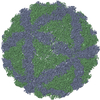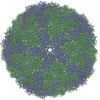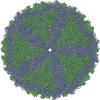[English] 日本語
 Yorodumi
Yorodumi- PDB-6s2c: Acquired functional capsid structures in metazoan totivirus-like ... -
+ Open data
Open data
- Basic information
Basic information
| Entry | Database: PDB / ID: 6s2c | ||||||||||||
|---|---|---|---|---|---|---|---|---|---|---|---|---|---|
| Title | Acquired functional capsid structures in metazoan totivirus-like dsRNA virus. | ||||||||||||
 Components Components | (Capsid protein Capsid) x 2 Capsid) x 2 | ||||||||||||
 Keywords Keywords |  VIRUS / VIRUS /  Mosquito / Mosquito /  Totivirus / Totivirus /  Totiviridae / Totivirus-like virus / Totiviridae / Totivirus-like virus /  dsRNA / dsRNA /  capsid capsid | ||||||||||||
| Function / homology | Double-stranded RNA binding motif / Double-stranded RNA binding motif / Double stranded RNA-binding domain (dsRBD) profile. / Double-stranded RNA-binding domain /  RNA binding / RNA binding /  Capsid protein Capsid protein Function and homology information Function and homology information | ||||||||||||
| Biological species |  Omono River virus Omono River virus | ||||||||||||
| Method |  ELECTRON MICROSCOPY / ELECTRON MICROSCOPY /  single particle reconstruction / single particle reconstruction /  cryo EM / Resolution: 3.2 Å cryo EM / Resolution: 3.2 Å | ||||||||||||
 Authors Authors | Okamoto, K. / Larsson, S.D.D. / Maia, R.N.C.F. / Murata, K. / Hajdu, J. / Iwasaki, K. / Miyazaki, N. | ||||||||||||
| Funding support |  Sweden, 3items Sweden, 3items
| ||||||||||||
 Citation Citation |  Journal: Structure / Year: 2020 Journal: Structure / Year: 2020Title: Acquired Functional Capsid Structures in Metazoan Totivirus-like dsRNA Virus. Authors: Kenta Okamoto / Ricardo J Ferreira / Daniel S D Larsson / Filipe R N C Maia / Haruhiko Isawa / Kyoko Sawabe / Kazuyoshi Murata / Janos Hajdu / Kenji Iwasaki / Peter M Kasson / Naoyuki Miyazaki /    Abstract: Non-enveloped icosahedral double-stranded RNA (dsRNA) viruses possess multifunctional capsids required for their proliferation. Whereas protozoan/fungal dsRNA viruses have a relatively simple capsid ...Non-enveloped icosahedral double-stranded RNA (dsRNA) viruses possess multifunctional capsids required for their proliferation. Whereas protozoan/fungal dsRNA viruses have a relatively simple capsid structure, which suffices for the intracellular phase in their life cycle, metazoan dsRNA viruses have acquired additional structural features as an adaptation for extracellular cell-to-cell transmission in multicellular hosts. Here, we present the first atomic model of a metazoan dsRNA totivirus-like virus and the structure reveals three unique structural traits: a C-terminal interlocking arm, surface projecting loops, and an obstruction at the pore on the 5-fold symmetry axis. These traits are keys to understanding the capsid functions of metazoan dsRNA viruses, such as particle stability and formation, cell entry, and endogenous intraparticle transcription of mRNA. On the basis of molecular dynamics simulations of the obstructed pore, we propose a possible mechanism of intraparticle transcription in totivirus-like viruses, which dynamically switches between open and closed states of the pore(s). | ||||||||||||
| History |
|
- Structure visualization
Structure visualization
| Movie |
 Movie viewer Movie viewer |
|---|---|
| Structure viewer | Molecule:  Molmil Molmil Jmol/JSmol Jmol/JSmol |
- Downloads & links
Downloads & links
- Download
Download
| PDBx/mmCIF format |  6s2c.cif.gz 6s2c.cif.gz | 292.9 KB | Display |  PDBx/mmCIF format PDBx/mmCIF format |
|---|---|---|---|---|
| PDB format |  pdb6s2c.ent.gz pdb6s2c.ent.gz | 238.4 KB | Display |  PDB format PDB format |
| PDBx/mmJSON format |  6s2c.json.gz 6s2c.json.gz | Tree view |  PDBx/mmJSON format PDBx/mmJSON format | |
| Others |  Other downloads Other downloads |
-Validation report
| Arichive directory |  https://data.pdbj.org/pub/pdb/validation_reports/s2/6s2c https://data.pdbj.org/pub/pdb/validation_reports/s2/6s2c ftp://data.pdbj.org/pub/pdb/validation_reports/s2/6s2c ftp://data.pdbj.org/pub/pdb/validation_reports/s2/6s2c | HTTPS FTP |
|---|
-Related structure data
| Related structure data |  10087MC M: map data used to model this data C: citing same article ( |
|---|---|
| Similar structure data |
- Links
Links
- Assembly
Assembly
| Deposited unit | 
|
|---|---|
| 1 | x 60
|
- Components
Components
| #1: Protein |  Capsid CapsidMass: 91202.719 Da / Num. of mol.: 1 / Source method: isolated from a natural source / Source: (natural)  Omono River virus / References: UniProt: E1CI69 Omono River virus / References: UniProt: E1CI69 |
|---|---|
| #2: Protein |  Capsid CapsidMass: 91436.969 Da / Num. of mol.: 1 / Source method: isolated from a natural source / Source: (natural)  Omono River virus / References: UniProt: E1CI69 Omono River virus / References: UniProt: E1CI69 |
-Experimental details
-Experiment
| Experiment | Method:  ELECTRON MICROSCOPY ELECTRON MICROSCOPY |
|---|---|
| EM experiment | Aggregation state: PARTICLE / 3D reconstruction method:  single particle reconstruction single particle reconstruction |
- Sample preparation
Sample preparation
| Component | Name: Omono River virus / Type: VIRUS Details: Omono River virus particles from C6/36 mosquito cells Entity ID: all / Source: NATURAL |
|---|---|
| Molecular weight | Experimental value: NO |
| Source (natural) | Organism:  Omono River virus / Strain: AK4 Omono River virus / Strain: AK4 |
| Details of virus | Empty: YES / Enveloped: NO / Isolate: STRAIN / Type: VIRION |
| Natural host | Organism: Aedes |
| Virus shell | Name: Capsid / Diameter: 420 nm / Triangulation number (T number): 1 / Diameter: 420 nm / Triangulation number (T number): 1 |
| Buffer solution | pH: 7.5 |
| Buffer component | Conc.: 100 mM / Name: ammonium acetate / Formula: C2H7NO2 |
| Specimen | Conc.: 1.4 mg/ml / Embedding applied: NO / Shadowing applied: NO / Staining applied : NO / Vitrification applied : NO / Vitrification applied : YES : YES |
| Specimen support | Grid material: COPPER |
Vitrification | Instrument: FEI VITROBOT MARK III / Cryogen name: ETHANE / Humidity: 100 % / Chamber temperature: 277 K |
- Electron microscopy imaging
Electron microscopy imaging
| Experimental equipment |  Model: Titan Krios / Image courtesy: FEI Company |
|---|---|
| Microscopy | Model: FEI TITAN KRIOS |
| Electron gun | Electron source : :  FIELD EMISSION GUN / Accelerating voltage: 300 kV / Illumination mode: FLOOD BEAM FIELD EMISSION GUN / Accelerating voltage: 300 kV / Illumination mode: FLOOD BEAM |
| Electron lens | Mode: BRIGHT FIELD Bright-field microscopy / Nominal magnification: 59000 X / Nominal defocus max: 225 nm / Nominal defocus min: 100 nm Bright-field microscopy / Nominal magnification: 59000 X / Nominal defocus max: 225 nm / Nominal defocus min: 100 nm |
| Specimen holder | Cryogen: NITROGEN / Specimen holder model: FEI TITAN KRIOS AUTOGRID HOLDER |
| Image recording | Average exposure time: 1 sec. / Electron dose: 20 e/Å2 / Detector mode: COUNTING / Film or detector model: FEI FALCON II (4k x 4k) / Num. of real images: 4521 |
| Image scans | Movie frames/image: 16 |
- Processing
Processing
| EM software |
| ||||||||||||||||||||||||||||||||||||||||
|---|---|---|---|---|---|---|---|---|---|---|---|---|---|---|---|---|---|---|---|---|---|---|---|---|---|---|---|---|---|---|---|---|---|---|---|---|---|---|---|---|---|
CTF correction | Type: PHASE FLIPPING AND AMPLITUDE CORRECTION | ||||||||||||||||||||||||||||||||||||||||
| Particle selection | Num. of particles selected: 30986 | ||||||||||||||||||||||||||||||||||||||||
| Symmetry | Point symmetry : I (icosahedral : I (icosahedral ) ) | ||||||||||||||||||||||||||||||||||||||||
3D reconstruction | Resolution: 3.2 Å / Resolution method: FSC 0.143 CUT-OFF / Num. of particles: 30363 / Symmetry type: POINT | ||||||||||||||||||||||||||||||||||||||||
| Atomic model building | Protocol: AB INITIO MODEL / Space: REAL / Target criteria: Cross-correlation coefficient |
 Movie
Movie Controller
Controller










 PDBj
PDBj
